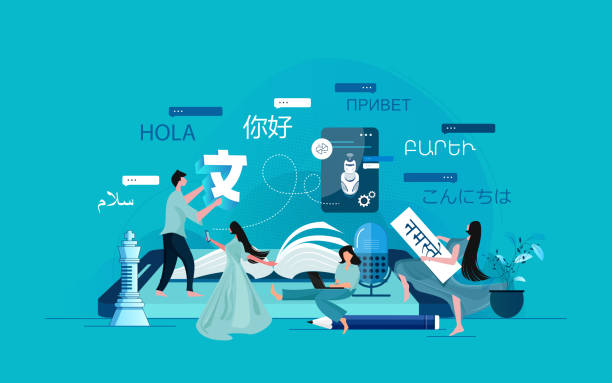Oral Versus Written: Distinguishing Between Interpreters and Translators
 Navigating the world of language professionals, we often encounter two key roles: interpreters and translators. While they both work with languages, their tasks and skills are quite distinct.
Navigating the world of language professionals, we often encounter two key roles: interpreters and translators. While they both work with languages, their tasks and skills are quite distinct.
Interpreters focus on the spoken word, converting speech from one language to another in real time. This is essential in meetings, conferences, and any situation where immediate understanding is crucial.
On the other hand, translators deal with the written word, meticulously transforming texts from one language to another, ensuring that the meaning and tone are accurately conveyed.
In this article, we will talk about the specific roles, skills, and applications of interpreters and translators, shedding light on what sets them apart and where their expertise is most effectively utilized.
Introduction to Language Professionals
Language professionals, comprising interpreters and translators, play a pivotal role in bridging communication barriers. Though their objectives align, their methods and mediums differ significantly.
The Role of Interpreters
 Interpreters are responsible for orally converting speech from one language to another. Their expertise lies in real-time translation during live events.
Interpreters are responsible for orally converting speech from one language to another. Their expertise lies in real-time translation during live events.
This demands not only an extensive grasp of languages but also the ability to quickly interpret cultural references and idiomatic expressions. Interpreters are critical in facilitating communication in diverse settings, such as international conferences, legal proceedings, and medical consultations.
The skill of an interpreter lies in accurately conveying spoken words, along with their context and nuances, to ensure mutual understanding among parties speaking different languages.
The Role of Translators
 On the other hand, translators focus on converting written content from one language to another. Their task extends beyond literal translation to encompass the adaptation of cultural nuances, maintaining the tone and style of the original text.
On the other hand, translators focus on converting written content from one language to another. Their task extends beyond literal translation to encompass the adaptation of cultural nuances, maintaining the tone and style of the original text.
Translators are integral in various domains, including literary translation, legal documentation, and technical manuals. The challenge for translators is to produce a document that is not only linguistically accurate but also contextually appropriate for the target audience.
Their work ensures that written materials are accessible and understandable to readers in different languages, maintaining the integrity and intent of the original text.
The Art of Interpretation
Interpreters play a crucial role in enabling clear and effective communication between people who speak different languages. Their work is not just about language fluency; it requires a deep understanding of cultural contexts and the ability to convey messages accurately and swiftly.
Types of Interpretation
There are primarily two types of interpretation: simultaneous and consecutive. Each type serves different purposes and settings.
Simultaneous Interpretation
In simultaneous interpretation, interpreters translate the spoken word in real-time, almost as soon as the speaker begins talking. This type of interpretation is common in large conferences or international meetings.
Here, interpreters typically sit in sound-proof booths, listen to the speaker through headphones, and speak the interpretation into a microphone. This interpretation is then relayed to the audience members who require it.
The United Nations, for example, relies heavily on simultaneous interpreters to facilitate multilingual communication among delegates.
Consecutive Interpretation
Consecutive interpretation, on the other hand, occurs after the speaker has finished speaking or takes a pause. The interpreter then relays what was said in the target language.
This method is often used in smaller settings like business meetings, medical appointments, or legal settings. It requires interpreters to have excellent memory and note-taking skills, as they need to recall and translate longer segments of speech accurately.
Skills Required for Effective Interpretation
 Effective interpreters possess a combination of linguistic proficiency, cultural knowledge, and technical skills. They must be able to process and translate spoken language quickly, often dealing with complex or technical subjects.
Effective interpreters possess a combination of linguistic proficiency, cultural knowledge, and technical skills. They must be able to process and translate spoken language quickly, often dealing with complex or technical subjects.
Interpreters must also be adept at managing stress and maintaining concentration over extended periods, especially in high-pressure environments like legal trials or medical emergencies.
Apart from linguistic skills, interpreters need to be well-versed in the cultural nuances of the languages they work with. This cultural sensitivity helps in accurately conveying not just the words, but also the intent and emotions behind them.
Additionally, interpreters must adhere to ethical standards, including confidentiality and impartiality, which are critical in many settings such as legal proceedings or diplomatic discussions.
The Craft of Translation
 Translating is a complex task that goes beyond word-for-word conversion. It requires a deep understanding of the original context, cultural nuances, and the intended message.
Translating is a complex task that goes beyond word-for-word conversion. It requires a deep understanding of the original context, cultural nuances, and the intended message.
Types of Translation
In the translation world, different fields require unique skills and approaches.
Literary Translation
In literary translation, the translator becomes a bridge between cultures. It's not just about the language, but also capturing the essence of the original text.
This means translating the humor, idioms, and cultural references in a way that resonates with the new audience. It’s a delicate balance, requiring not only linguistic skills but also a deep understanding of literary styles and cultural contexts.
Technical Translation
Technical translation, on the other hand, demands accuracy and a firm grasp of specialized terminology. This includes fields like law, medicine, engineering, and science.
Here, the translator must accurately convey complex concepts and industry-specific language. Any error, no matter how small, could have significant implications.
This necessitates a combination of linguistic expertise and sector-specific knowledge.
Key Skills for Translators
A successful translator must be proficient in both the source and target languages, understanding the intricacies of grammar, vocabulary, and colloquialisms
Additionally, they need to be excellent researchers, especially when dealing with texts that include cultural references or specialized terminology.
Attention to detail is crucial in ensuring accuracy and maintaining the integrity of the original message. Strong writing skills in the target language are essential to produce a translation that reads naturally, as if it was originally written in that language.
Contextual Differences Between Interpreting and Translating
When exploring the professional realms of interpreters and translators, it's easy to mix them up. However, their roles, skills, and work environments are distinct, making each one unique in its way.
Firstly, let's talk about the immediate environment and pace. Interpreters work in real-time.
They translate spoken words instantly, often in settings like conferences, legal proceedings, or medical appointments. This demands a high level of concentration and the ability to think quickly.
Translators, on the other hand, deal with written texts, such as books, documents, and websites. They have the advantage of time to analyze and refine their translations, making sure every word is perfectly chosen.
The nature of their work also dictates different skill sets. For interpreters, excellent listening skills and memory are crucial.
They need to accurately remember and convey spoken words in another language, sometimes for lengthy periods. Translators, in contrast, must have strong research skills and a deep understanding of the subject matter.
They often work on texts that require a specific knowledge base, like technical manuals or legal documents.
Another key difference is the level of interaction with clients. Interpreters often work face-to-face or via video conferencing, directly interacting with the people they are translating for.
This requires not only language skills but also cultural sensitivity and the ability to navigate various social contexts. Translators, while they may occasionally interact with clients for clarifications, primarily work alone, focusing deeply on the text.
Additionally, the tools and resources each profession relies on vary. Interpreters might use earpieces, microphones, and sometimes specialized interpreting software, especially in settings like the United Nations or European Parliament.
Translators, however, depend heavily on dictionaries, online resources, and translation memory software to ensure consistency and accuracy in their work.
Real-World Applications
Where Interpreters Shine
Interpreters are essential in various settings, playing a critical role in facilitating communication. In legal courts, for instance, interpreters ensure that non-native speakers understand proceedings and can participate fully.
Healthcare is another area where interpreters are vital. They help in breaking down language barriers between patients and healthcare providers, contributing significantly to the accuracy of diagnoses and effectiveness of treatments.
In emergency situations, where every word and every second count, the role of medical interpreters becomes even more crucial.
In the business world, interpreters enable companies to expand their global reach. During international meetings and negotiations, interpreters help in clearly conveying complex ideas and cultural nuances that are essential for successful business relationships.
They also play a key role in international conferences, where participants from various linguistic backgrounds come together to share ideas and knowledge.
The Realm of Translators
Translators, on the other hand, are the backbone of cross-cultural written communication. They help businesses reach a wider audience by translating websites, marketing materials, and product manuals.
In the literary world, translators bring foreign literature to new readers, opening up cultures and ideas to a global audience. The work of a translator is crucial in preserving the author's voice and intent, making the reading experience enjoyable and authentic for readers in another language.
Legal translation is another critical area. Legal documents like contracts, patents, and court documents require precise and accurate translation.
A translator's expertise ensures that all parties understand the legal texts, which is fundamental in international law and business dealings.
Academic translation also plays a significant role in spreading knowledge across linguistic boundaries. Translators enable researchers and scholars to access and share scientific studies, journals, and academic works globally, contributing to the advancement of knowledge and understanding across diverse fields.
The Impact of Technology
Technology has significantly changed the landscape for both interpreters and translators. The advancements are not about replacing human skills, but rather about enhancing accuracy and efficiency in their work.
Technological Tools for Interpreters
In the world of interpretation, technology plays a supportive role. For instance, digital glossaries and specialized software help interpreters prepare for assignments by offering quick access to relevant terminology and background information.
This is particularly useful in complex fields like legal or medical interpretation, where precision is crucial.
Software that supports remote interpreting has also become increasingly important. Platforms like Zoom and Microsoft Teams now offer features tailored for interpreters.
This development has opened up new possibilities for remote work, allowing interpreters to provide their services across the globe without the need for physical presence.
Advancements in Translation Technology
For translators, technology has been a game changer in several ways. Translation memory tools, such as SDL Trados and MemoQ, allow translators to reuse previously translated segments.
This not only speeds up the translation process but also ensures consistency across large projects.
Machine translation, like Google Translate, has seen significant improvements. While it's not perfect and cannot replace human translators, it serves as a helpful tool for initial drafts or understanding the general context of a text.
Translators often use these tools as a starting point, refining and adapting the output to ensure it meets high standards of quality and cultural relevance.
Additionally, advancements in AI are helping to tailor translations for specific industries and audiences. AI-driven tools can now better handle nuances in language and are continuously learning from human corrections, leading to more accurate translations over time.
Challenges Faced in Both Professions
The life of an interpreter or translator isn't just about switching between languages; it comes with its own set of unique challenges. One of the major hurdles is keeping up with the constant changes in language and industry-specific jargon.
Languages are living entities, always evolving, and staying updated requires continuous learning and adaptation.
For interpreters, one of the biggest challenges is the high-stress environment. Imagine being in a courtroom or a medical emergency, where every word you interpret could have significant consequences.
The pressure to deliver accurate and timely interpretation can be immense. Additionally, interpreters often work in varied settings, each with its own set of challenges.
For instance, interpreting in a noisy conference hall requires different skills and technology compared to a one-on-one legal consultation.
Translators, on the other hand, often face the challenge of isolation. Unlike interpreters, who are physically present in the settings they work in, translators usually work alone.
This can lead to feelings of disconnection and can impact mental well-being. Translating complex or technical documents requires not just language skills, but also a deep understanding of the subject matter, which can be quite demanding.
Another significant challenge is dealing with cultural nuances. Both interpreters and translators need to have a deep understanding of the cultures involved in the languages they work with.
A word-for-word translation or interpretation might not always convey the intended meaning, especially when idiomatic expressions or cultural references are involved.
The development of technology, like AI and machine translation, also poses a challenge. While these tools can aid in the work, there's the constant need to stay updated with the latest technological advancements.
Plus, there's the underlying fear and uncertainty about these technologies replacing human jobs, which adds to the professional anxiety.
Lastly, the irregular and often unpredictable work hours can be tough. Freelance interpreters and translators especially may go through periods of intense work followed by slow periods, which can lead to financial instability.
Making the Right Choice for Your Needs
Choosing between an interpreter and a translator is a practical decision that hinges on your specific needs. Let's break it down to help you decide who to call upon when facing a language barrier.
For Live Communication, Go with an Interpreter
If you're hosting a conference with international attendees, conducting a business meeting with foreign partners, or dealing with legal or medical situations involving non-native speakers, an interpreter is essential.
They provide real-time language conversion, allowing for smooth and effective communication. Remember, interpreters are skilled not just in language, but also in picking up on cultural cues and nuances of spoken dialogue.
When It's Written, Choose a Translator
Translators are the go-to professionals for converting written materials. This includes documents like contracts, brochures, websites, and even books.
A translator ensures that the written text is accurately conveyed in another language, which is vital for legal documents where every word matters. Additionally, for marketing materials, a translator can adapt the message to fit the cultural context of the target audience, which is crucial for resonating with them.
Consider the Complexity and Subject Matter
For specialized subjects like law, medicine, or technology, you need professionals who not just understand the language but also the subject matter. Legal translators and interpreters, for instance, are familiar with legal terminologies and procedures.
The same goes for medical or technical translation and interpretation. It’s not just about language skills; it’s about understanding the field.
Don’t Forget Confidentiality and Sensitivity
In situations where sensitive information is involved, like in legal cases or healthcare settings, confidentiality is key. Professional interpreters and translators are bound by ethical standards to maintain confidentiality, which is crucial for trust and integrity in sensitive scenarios.
Availability and Accessibility
Consider the availability of these professionals. Interpreters might need to be physically present, or you could use remote interpreting services. Translators, on the other hand, can work from anywhere, giving you more flexibility, especially if you're dealing with international partners.
Conclusion
Interpreters and translators play a critical role in today's interconnected world. Interpreters excel in live, verbal communication, essential for meetings and conferences where instant understanding is needed.
Translators, in contrast, focus on converting written materials, crucial for accurately translating documents and literature.
Their work is key to overcoming language barriers in various fields, from business to international relations. Both professions require continuous learning and adaptability, especially in the face of technological advancements.
For those seeking these services, it's important to understand their distinct roles to choose the appropriate expert for your needs. Whether it's a spoken conversation or a written document, their skills are vital for effective communication across languages.
Are you navigating the complex world of language interpretation and translation?
Look no further than Interpreter IO, your comprehensive solution for managing language services. Whether it's for courts, hospitals, call centers, or agencies, Interpreter IO streamlines the process, ensuring efficient scheduling and effective communication.
From onsite interpreting to telephone and video remote interpreting, this platform adapts to your specific needs, breaking down language barriers with ease.
Discover how Interpreter IO can transform your language access approach.
Visit Interpreter IO to learn more about their innovative services and how they can assist you in connecting with a multilingual audience more effectively.
